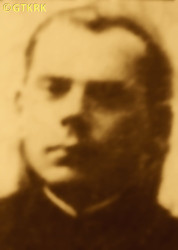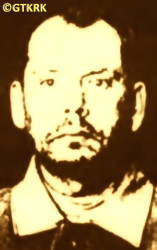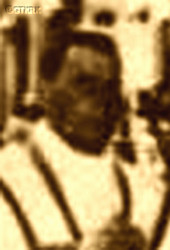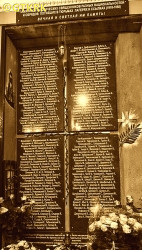Roman Catholic
St Sigismund parish
05-507 Słomczyn
85 Wiślana Str.
Konstancin deanery
Warsaw archdiocese, Poland
full list:
displayClick to display full list

searchClick to search full list by categories
wyświetlKliknij by wyświetlić pełną listę po polsku

szukajKliknij by przeszukać listę wg kategorii po polsku

Martyrology of the clergy — Poland
XX century (1914 – 1989)
personal data
surname
PUCZKAR-CHMIELEWSKI
forename(s)
Adam
function
diocesan priest
creed
Latin (Roman Catholic) Church RCmore on
en.wikipedia.org
[access: 2014.09.21]
diocese / province
Mogilev archdiocesemore on
en.wikipedia.org
[access: 2013.06.23]
date and place
of death
01.09.1938

GuLAGGuLAG slave labour camp network
today: name and site unknown
details of death
In 1920 during Polish–Russian war arrested for the first time.
Held by the Russians as a hostage and sent to Poland (prob. in exchange of prisoners).
Withdrawn however from the transport by Church authorities — remained in Minsk.
Numerous times interrogated and persecuted by the Russian GPU.
Finally arrested by the Russians on 26.07.1933.
Tortured.
On 24.02.1934, pursuant to Art. 68, 72 and 76 of Belarusian Penal Code, sentenced by criminal Russian GPU Council kangaroo court to 10 years of slave labour.
On 01.04.1934 deported to Dmitrowsk camp concentration, next in 05.1934 to Mitino camp.
In 07.1934 deported to PRLp KemLag transit camp, and two months later to a slave concentration camp ITL SLON on Solovetsky Islands.
There lost a leg — was chained to the wheelbarrow and from abrasions got an infection resulting in leg loss.
In 1938 arrested for the last time and sentenced to death (according to some sources sentence was pronounced on 11.08.1938).
Murdered by Russians in unknown circumstances.
cause of death
murder
perpetrators
Russians
sites and events
11.08.1937 Russian genocideClick to display the description, 09.10.1937 judicial murderClick to display the description, Great Purge 1937Click to display the description, ITL SLONClick to display the description, PRLp KemLagClick to display the description, ITL BelbaltLagClick to display the description, GulagClick to display the description, MinskClick to display the description
date and place
of birth
24.12.1891

Ivyanetstoday: Valozhyn dist., Minsk reg., Belarus
more on
en.wikipedia.org
[access: 2020.12.11]
presbyter (holy orders)
ordination
1916

positions held
c. 1929 – 1933
parish priest — Minsktoday: Minsk city reg., Belarus
more on
en.wikipedia.org
[access: 2020.07.31] ⋄ Name of the Blessed Virgin Mary RC cathedral church — also: minister of 18 other parishes without pastors, including a parish in Minsk
from c. 1920
parish priest — Minsktoday: Minsk city reg., Belarus
more on
en.wikipedia.org
[access: 2020.07.31] ⋄ St Simon and St Helen RC parish ⋄ Minsktoday: Minsk city reg., Belarus
more on
en.wikipedia.org
[access: 2020.07.31] RC deanery — also ministering in the parishes Zasław, Wołczkiewicze, Kojdanów
c. 1918 – c. 1920
vicar — Irkutsktoday: Irkutsk oblast, Russia
more on
en.wikipedia.org
[access: 2022.04.17] ⋄ Assumption of the Blessed Virgin Mary RC parish ⋄ Irkutsktoday: Irkutsk oblast, Russia
more on
en.wikipedia.org
[access: 2022.04.17] RC deanery — on 17.04.1918 founded the Polish Scout Team in Irkutsk
1916 – c. 1917
vicar — Babruysktoday: Babruysk dist., Mogilev reg., Belarus
more on
en.wikipedia.org
[access: 2020.12.11] ⋄ Immaculate Conception of the Blessed Virgin Mary RC parish ⋄ Babruysktoday: Babruysk dist., Mogilev reg., Belarus
more on
en.wikipedia.org
[access: 2020.12.11] RC deanery
till 1916
student — Sankt Petersburgtoday: Saint Petersburg city, Russia
more on
en.wikipedia.org
[access: 2020.07.31] ⋄ philosophy and theology, Metropolitan Theological Seminary
sites and events
descriptions
11.08.1937 Russian genocide: On 11.08.1937 Russian leader Stalin decided and NKVD head, Nicholas Jeżow, signed a «Polish operation» executive order no 00485. 139,835 Poles living in Russia were thus sentenced summarily to death. According to the records of the „Memorial” International Association for Historical, Educational, Charitable and Defense of Human Rights (Rus. Международное историко‐просветительское, правозащитное и благотворительное общество „Мемориал”), specialising with historical research and promoting knowledge about the victims of Russian repressions — 111,091 were murdered. 28,744 were sentenced to deportation to concentration camps in Gulag. Altogether however more than 100,000 Poles were deported, mainly to Kazakhstan, Siberia, Kharkov and Dniepropetrovsk. According to some historians, the number of victims should be multiplied by at least two, because not only the named persons were murdered, but entire Polish families (the mere suspicion of Polish nationality was sufficient). Taking into account the fact that the given number does not include the genocide in eastern Russia (Siberia), the number of victims may be as high as 500,000 Poles. (more on: en.wikipedia.orgClick to attempt to display webpage
[access: 2016.03.14])
09.10.1937 judicial murder: On 09.10.1937 a «NKVD Troika» — a genocidal Russian kangaroo court from Sankt Petersburg consisting of three „summary judges” — sentenced to death, at a single stroke of pen, 1,116 Solovetsky Islands concentration camp’s prisoners. 1,111 names are known — they were murdered in Sandarmokh. The names of the genocidal „judges” are also know. It is also known that on 25.11.1937 similar «NKVD Troika» Russian genocidal kangaroo court sentenced to death few remaining in Solovetsky Islands Catholic priests. All in 12.1937 were transported out towards Sankt Petersburg and murdered prob. in ITL SvirLag camp (or in Sankt Petersburg). (more on: pl.wikipedia.orgClick to attempt to display webpage
[access: 2016.03.14])
Great Purge 1937: „Great Terror” (also «Great Purge», also called „Yezhovshchyna” after the name of the then head of the NKVD) — a Russian state action of political terror, planned and directed against millions of innocent victims — national minorities, wealthier peasants (kulaks), people considered opponents political, army officers, the greatest intensity of which took place from 09.1936 to 08.1938. It reached its peak starting in the summer of 1937, when Art. 58‐14 of the Penal Code about „counter‐revolutionary sabotage” was passed , which became the basis for the „legalization” of murders, and on 02.07.1937 when the highest authorities of Russia, under the leadership of Joseph Stalin, issued a decree on the initiation of action against the kulaks. Next a number of executive orders of the NKVD followed, including No. 00439 of 25.07.1937, starting the liquidation of 25,000‐42,000 Germans living in Russia (mainly the so‐called Volga Germans); No. 00447 of 30.07.1937, beginning the liquidation of „anti‐Russian elements”, and No. 00485[2] of 11.08.1937, ordering the murder of 139,835 people of Polish nationality (the latter was the largest operation of this type — encompassed 12.5% of all those murdered during the «Great Purge», while Poles constituted 0.4% of the population). In the summer of 1937 Polish Catholic priests held in Solovetsky Islands, Anzer Island and ITL BelbaltLag were locked in prison cells (some in Sankt Petersburg). Next in a few kangaroo, murderous Russian trials (on 09.10.1937, 25.11.1937, among others) run by so‐called «NKVD Troika» all were sentenced to death. They were subsequently executed by a single shot to the back of the head. The murders took place either in Sankt Petersburg prison or directly in places of mass murder, e.g. Sandarmokh or Levashov Wilderness, where their bodies were dumped into the ditches. Other priests were arrested in the places they still ministered in and next murdered in local NKVD headquarters (e.g. in Minsk in Belarus), after equally genocidal trials run by aforementioned «NKVD Troika» kangaroo courts.
ITL SLON: Russian Rus. Исправи́тельно‐Трудово́й Ла́герь (Eng. Corrective Labor Camp) ITL Rus. Солове́цкий ла́герь осо́бого назначе́ния Ла́герь (Eng. Solovetsky Special Purpose Camp) SLON — concentration and slave forced labor camp (within what was to become Gulag complex) — headquartered in Solovetsky Islands in Arkhangelsk Oblast. Founded on 13.10.1923 in a famous Orthodox monastery. In the 1920s, one of the first and largest concentration camps in Russia. The place of slave labor of prisoners — at forest felling, sawmills, peat extraction, fishing, loading work on the Murmansk Railway Main Line, in road construction, production of food and consumer goods, at the beginning of the construction of the White Sea ‐ Baltic canal, etc. The concept of the later system of Russian Gulag concentration camps prob. had its origins in the Solovetsky Islands camp — from there the idea spread to the camps in the area covered by the construction of the White Sea ‐ Baltic canal, i.e. ITL BelBaltLag, and from there further, to the entire territory of the Russian state. From the network of camps on the Solovetsky Islands — also called the Solovetsky Islands archipelago — prob. also comes the concept of the „Gulag Archipelago” created by Alexander Solzhenitsyn. It is estimated that tens to hundreds of thousands of prisoners passed through the Solovetsky Islands concentration camps. At its peak, c. 72,000 prisoners were held there: e.g. 14,810 (12.1927); 12,909 (03.1928); 65,000 (1929); 53,123 (01.01.1930); 63,000 (01.06.1930); 71,800 (01.01.1931); 15,130 (1932); 19,287 (1933) — c. 43,000 of whom were murdered, including the years 1937‐1938 when c. 9,500 prisoners were transported from the camp and murdered in several places of mass executions, including Sandarmokh, Krasny Bor and Lodeynoye Polye. Among them were many Catholic and Orthodox priests. After the National Socialist Party came to power in Germany in 1933, a German delegation visited the ITL SLON camp, to „inspect” Russian solutions and adopt them later in German concentration camps. It operated until 04.12.1933, with a break from 16.11.1931 to 01.01.1932, when it was part of and later became a subcamp of the ITL BelBaltLag camp. It operated as such until 1939 (from 1936 as a prison). (more on: old.memo.ruClick to attempt to display webpage
[access: 2024.04.08])
PRLp KemLag: Russian Rus. Пересыльно‐Распределительный Лагпункт (Eng. Transfer and Distribution Camp) PRLp Rus. Кемский (Eng. Kemskiy) — a transit sub‐camp (within the Gulag complex, first subordinated to ITL SLON on the Solovetsky Islands, and from 04.12.1933 to ITL BelBaltLag) — based in Kem, Rep. Karelia, on the White Sea, at the end of the Murmansk railway line side branch. Established in 1923 as the first concentration camp in Russia. Then operated on the Ostrov island (today a peninsula) as a transfer point to the Solovetsky Islands and the ITL SLON camp. At its peak, c. 70,000 prisoners passed through it (1931), including many Catholic and Orthodox priests. It ended its operations in 1939 — after 1933 and the formal closure of ITL SLON, a branch of ITL BelBaltLag operated on the Solovetsky Islands, and in the years 1937‐1939 a special NKVD prison Rus. Соловецкая тюрьма особого назначения (Eng. Solovetsky special purpose prison) STON, for which PRLp KemLag was still a transit sub‐camp. (more on: www.gulagmuseum.orgClick to attempt to display webpage
[access: 2014.12.20])
ITL BelbaltLag: Russian Rus. Исправи́тельно‐Трудово́й Ла́герь (Eng. Corrective Labor Camp) ITL Rus. Беломоро‐Балтийский (Eng. White Sea ‐ Baltic Sea) — concentration and slave forced labor camp (within the Gulag complex) — headquartered in Medvezhjegorsk on Lake Onega, and in 1933‐1934 also in the town of Nadvoytsy (both then in the Karelo‐Finnish Republic, today the Karelian Republic). Founded on 16.11.1931, on the basis of the former ITL SLON camp (i.a. on the Solovetsky islands on the White Sea). Prisoners slaved at the construction of a canal between the White Sea and the Baltic Sea (opened on 30.06.1933). Later, as part of the newly created White Sea ‐ Baltic Sea Combine, managed by the criminal GPU (later the genocidal NKVD), slaved on forest clearing, in sawmills, on the construction of factories for wooden products and paper production, on the construction of hydroelectric power plants (Tulomskaya and Onda), a nickel factory and alcohol distilleries, construction of ports, and laying of railway lines., etc. One of heads of the camp was a Jew, Naftali Frenkel, regarded as the originator of the Gulag system. At its peak c. 110,000 prisoners were held there: e.g. 107,900 (12.1932); 70,373 (01.01.1934); 66,418 (01.01.1935); 90,290 (01.01.1936); 58,965 (01.01.1937); 79,232 (01.10.1938); 86,567 (01.01.1939); 71,269 (01.01.1941); 67,928 (15.06.1941). In 1938 there were 3,946 women among them. According to official data, 12,300 perished during the construction of the canal itself — according to unofficial data, from 50,000 to 300,000. The camp operated until 18.09.1941, and the entire project — in economic terms — turned out to be a total failure. (more on: ru.wikipedia.orgClick to attempt to display webpage
[access: 2022.09.02], en.wikipedia.orgClick to attempt to display webpage
[access: 2014.05.09])
Gulag: The acronym Gulag comes from the Rus. Главное управление исправительно‐трудовых лагерей и колоний (Eng. Main Board of Correctional Labor Camps). The network of Russian concentration camps for slave labor was formally established by the decision of the highest Russian authorities on 27.06.1929. Control was taken over by the OGPU, the predecessor of the genocidal NKVD (from 1934) and the MGB (from 1946). Individual gulags (camps) were often established in remote, sparsely populated areas, where industrial or transport facilities important for the Russian state were built. They were modeled on the first „great construction of communism”, the White Sea‐Baltic Canal (1931‐1932), and Naftali Frenkel, of Jewish origin, is considered the creator of the system of using forced slave labor within the Gulag. He went down in history as the author of the principle „We have to squeeze everything out of the prisoner in the first three months — then nothing is there for us”. He was to be the creator, according to Alexander Solzhenitsyn, of the so‐called „Boiler system”, i.e. the dependence of food rations on working out a certain percentage of the norm. The term ZEK — prisoner — i.e. Rus. заключенный‐каналоармец (Eng. canal soldier) — was coined in the ITL BelBaltLag managed by him, and was adopted to mean a prisoner in Russian slave labor camps. Up to 12 mln prisoners were held in Gulag camps at one time, i.e. c. 5% of Russia's population. In his book „The Gulag Archipelago”, Solzhenitsyn estimated that c. 60 mln people were killed in the Gulag until 1956. Formally dissolved on 20.01.1960. (more on: en.wikipedia.orgClick to attempt to display webpage
[access: 2024.04.08])
Minsk: Russian prison. In 1937 site of mass murders perpetrated by the Russians during a „Great Purge”. After Russian invasion of Poland in 09.1939 and start of the World War II place of incarceration of many Poles, In 06.1941, under attack by Germans, Russians murdered there a group of Polish prisoner kept in Central and co‐called American prisons in Mińsk. The rest were driven towards Chervyen in a „death march” (10,000‐20,000 prisoners perished), into Russia. (more on: pl.wikipedia.orgClick to attempt to display webpage
[access: 2013.08.17])
sources
personal:
katolicy1844.republika.plClick to attempt to display webpage
[access: 2021.12.19], archive.todayClick to attempt to display webpage
[access: 2014.05.09], genealogia.okiem.plClick to attempt to display webpage
[access: 2024.03.26], ivenec.euClick to attempt to display webpage
[access: 2014.12.20], biographies.library.nd.eduClick to attempt to display webpage
[access: 2014.12.20]
bibliographical:
„Fate of the Catholic clergy in USSR 1917‐1939. Martyrology”, Roman Dzwonkowski, SAC, ed. Science Society KUL, 2003, Lublin
original images:
traditio.wikiClick to attempt to display webpage
[access: 2019.05.30], www.iwieniec.euClick to attempt to display webpage
[access: 2014.11.14], ipn.gov.plClick to attempt to display webpage
[access: 2019.02.02]
LETTER to CUSTODIAN/ADMINISTRATOR
If you have an Email client on your communicator/computer — such as Mozilla Thunderbird, Windows Mail or Microsoft Outlook, described at WikipediaPatrz:
en.wikipedia.org, among others — try the link below, please:
LETTER to CUSTODIAN/ADMINISTRATORClick and try to call your own Email client
If however you do not run such a client or the above link is not active please send an email to the Custodian/Administrator using your account — in your customary email/correspondence engine — at the following address:

giving the following as the subject:
MARTYROLOGY: PUCZKAR-CHMIELEWSKI Adam
To return to the biography press below:
 Click to return to biography
Click to return to biography











